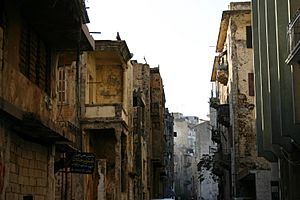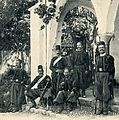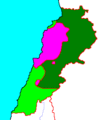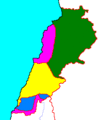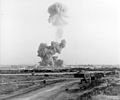Lebanese Civil War facts for kids
Quick facts for kids Lebanese Civil War |
|||||||
|---|---|---|---|---|---|---|---|
| Part of the Arab Cold War, the Arab–Israeli conflict | |||||||
 The Martyr's Square statue in Beirut, 1982, during the civil war |
|||||||
|
|||||||
The Lebanese Civil War (Arabic: الحرب الأهلية اللبنانية, romanized: Al-Ḥarb al-Ahliyyah al-Libnāniyyah) was a long and complicated war in Lebanon. It lasted for 15 years, from 1975 to 1990. This war caused a lot of damage and sadness. About 120,000 people lost their lives. Many more were forced to leave their homes. By 2012, about 76,000 people were still displaced inside Lebanon. Nearly one million people moved away from Lebanon because of the war.
Contents
Why the War Started
Before the war, Lebanon was home to many different groups of people. These groups often had different religions and ways of life. For example, Sunni Muslims and Christians lived mostly in cities along the coast. Shia Muslims lived in the south and the Beqaa Valley. People in the mountains were mostly Druze and Christians.
Lebanon's government was set up to give a lot of power to Maronite Christians. This system was put in place when France ruled Lebanon from 1920 to 1943. It meant Christians had a leading role in the government. However, Lebanon also had a large Muslim population. Many groups wanted more power for Muslims. Some also wanted Lebanon to be more connected to other Arab countries. Others supported left-wing ideas. These groups often disagreed with the pro-Western government.
The creation of Israel in 1948 also caused problems. Many Palestinian refugees moved to Lebanon in 1948 and 1967. This changed the number of Muslims compared to Christians in Lebanon. The Cold War also made things worse. Maronite Christians often supported Western countries. Meanwhile, many Muslim and Arab groups supported the Soviet Union. These different views caused a lot of tension in Lebanon.
How the War Unfolded
The fighting began in 1975. It started between Maronite Christian groups and Palestinian forces. The Palestinian forces were mainly from the Palestine Liberation Organization (PLO). Soon, other groups joined the fight. These included left-wing, Arab nationalist, and Muslim Lebanese groups. They formed an alliance with the Palestinians.
During the war, groups often changed sides quickly. It was hard to predict who would be fighting whom. Other countries also got involved. Israel and Syria both sent troops and supported different sides. This made the war even more complicated.
International Peacekeeping forces also came to Lebanon. These included the Multinational Force in Lebanon and the United Nations Interim Force in Lebanon. They tried to help stop the fighting and keep peace.
The War's End
The war began to end with the Taif Agreement in 1989. This agreement was worked out by the Arab League. It aimed to find solutions to the conflict.
In March 1991, a new law was passed. It pardoned people for political crimes committed during the war. This helped people move on. In May 1991, most armed groups were told to give up their weapons. The only exception was Hezbollah. The Lebanese Armed Forces (LAF) then started to rebuild. They became Lebanon's main national army. Even after the war, some tensions between Sunni and Shia Muslims remained.
After the War
Syrian Presence
After the war, Syria had a strong influence in Lebanon. This was especially hard for the Maronite Christian population. Many of their leaders were forced to leave the country. Some were even killed or put in jail.
In 2005, a famous Lebanese leader named Rafik Hariri was assassinated. This event led to the Cedar Revolution. Many Lebanese people protested, and Syria finally pulled its troops out of Lebanon on April 30, 2005.
Today, political groups in Lebanon often reflect the alliances from the Civil War. For example, the March 14 Alliance includes Maronite and Sunni parties. The March 8 Alliance is led by Shia parties like Hezbollah and Amal. The ongoing Syrian civil war also affects politics in Lebanon today.
Long-Term Effects
Since the war ended, Lebanon has held several elections. Most of the armed groups have been weakened or disbanded. The Lebanese Armed Forces (LAF) have taken control of most of the country. After the 2006 conflict with Israel, the army moved into southern Lebanon. This was the first time in over 30 years they had full control there.
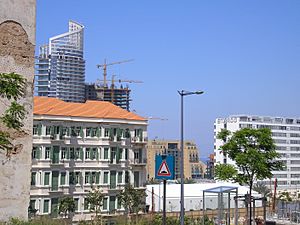
Lebanon has worked hard to rebuild since 1990. The downtown area of Beirut, the capital city, has been completely rebuilt.
How Many People Were Affected
It is thought that about 150,000 people died during the war. Another 100,000 people were permanently injured.
Around 900,000 people had to leave their homes. This was about one-fifth of Lebanon's population before the war. About 250,000 people moved out of Lebanon permanently.
Thousands of land mines are still buried in areas where fighting happened. These hidden mines are very dangerous. Some Westerners who were kidnapped in the 1980s were held until 1992. Tens of thousands of Lebanese people were also kidnapped or went missing during the war.
Over the 15 years of fighting, there were at least 3,641 car bombs. These bombs killed 4,386 people and injured thousands more.
In Popular Culture
The Lebanese Civil War has been shown in many songs, movies, and art.
- The British band The Human League released a song called "The Lebanon" in 1984. It was about the war and some sad events that happened.
- The Argentinean band GIT wrote "Buenas noches, Beirut" (Good night, Beirut) in 1986. This song was also about the war.
- The 1991 movie Out of Life by Maroun Baghdadi won an award at the 1991 Cannes Film Festival.
- In 2009, an art show called "The Road to Peace" was held in Beirut. It showed paintings, photos, and sculptures by Lebanese artists during the war.
- The 2008 movie Waltz with Bashir talks about the 1982 Israeli involvement in the war.
- The 2010 Canadian film Incendies shows the civil war and its effects.
- The 1995 children's book From Far Away by Robert Munsch is based on a true story. It's about a girl who comes to Canada as a refugee from a war, though the specific conflict is not named.
- Artist Nabil Kanso created paintings about the war, including "The Vortices of Wrath (Lebanon 1977)", "Lebanon (painting)", "Endless Night (painting)", and "Lebanon Summer 1982".
- The 2021 film Memory Box is based on the notebooks and tapes of co-director Joana Hadjithomas from when she was a teenager in Beirut during the war.
Images for kids
-
U.S. Marine sits in a foxhole outside Beirut during the 1958 Lebanon crisis
-
Picture of the 1983 Beirut barracks bombing
-
USS New Jersey fires a salvo against targets in the Shouf, 9 January 1984
See also
 In Spanish: Guerra civil libanesa para niños
In Spanish: Guerra civil libanesa para niños


